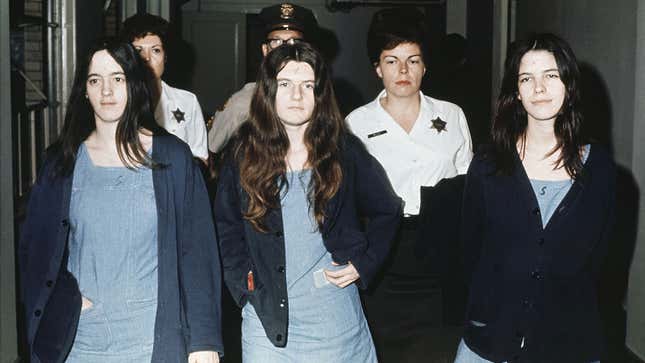

For those who consider Vincent Bugliosi’s Helter Skelter—his 1974 book about Charles Manson, the murders he ordered, and ensuing trial—to be canon, Tom O’Neill’s new book Chaos: Charles Manson, the CIA, and the Secret History of the Sixtiest History of the Sixties suggests a rift in the fabric of the universe as we know it. The product of some 20 years of exhaustive, obsessive research, Chaos suggests that the case made to the court by Bugliosi, who prosecuted the case before he wrote the definitive book about it, was fraudulent and that the entire “Helter Skelter” motive, which stated that Manson attempted to kick off a race war via the Tate-LaBianca murders of 1969, does not hold up to scrutiny in light of unearthed evidence. For one thing, according to O’Neill’s report, the relationship between Manson and record producer Terry Melcher (a previous resident of the house on Cielo Drive where Sharon Tate, Jay Sebring, Wojciech Frykowski, Abigail Folger, and Steven Parent were murdered), was more involved than it was conveyed during the trial—O’Neill says he found notes from two witness interviews that placed Melcher in the presence of Manson after the murders. This information was suppressed from the trial because, O’Neill suggests, it did not square with another part of Bugliosi’s suggested motive: Manson ordered murders to scare Melcher, who had refused to record the cult leader’s music.
Down the rabbit hole O’Neill goes, examining procedural mishandling (Manson Family member Susan Atkins’s lawyer was unceremoniously changed before her trial); evidence that the Los Angeles Sheriff’s Office already had eyes on Manson well in advance of the culture-upending murders; and possible Manson connections to the then-secret government programs of COINTELPRO, CHAOS, and MKUltra (the last of which centered on mind-control programs). O’Neill’s book is provocative and suggestive without being definitive—it is a piled-high pasta plate of loose ends. “My goal isn’t to say what did happen—it’s to prove that the official story didn’t,” O’Neill concedes in the book. “I’ve learned to accept the ambiguity.”
O’Neill hadn’t even read Helter Skelter—the premier gateway drug for many a Manson obsessive—before he was assigned by the now-defunct Premiere magazine in 1999 to write a retrospective piece about the chilling effects of the Manson murders in Hollywood pegged to the 30th anniversary of those crimes. That anniversary came and went. O’Neill stayed on the story for so long that, in his account, he parlayed his findings into a book deal with a massive payday, but then that deal was canceled when a chronicle of his findings failed to materialize (that deal, with Penguin, resulted in a lawsuit). Chaos, which is finally being released June 25 by Little, Brown and Company just weeks before the 50th anniversary of the Tate-LaBianca murders, chronicles O’Neill’s struggle to cohere his scraps of evidence into a book. Along the way came threats from his sources (including Bugliosi, who died in 2015), false leads, and a general sense of paranoia that he was becoming a conspiracy theorist.
Chaos’s title describes not just the CIA’s domestic espionage program of the ‘60s and ‘70s—it also describes the book’s aesthetic. Reading it made me feel like my brain was melting out of my ears. Earlier this week I talked to O’Neill by phone; our conversation, edited for length, clarity, and flow, is below.
JEZEBEL: At points in the book, you express a certain paranoia of becoming a conspiracy theorist. Do you think that’s ultimately a fair description of you?
TOM O’NEILL: No, I don’t think so. If I were you would have gotten a final answer in the book, and I have pretty strong ideas on what did or didn’t happen. I won’t put them in because I can’t substantiate them. A couple of them conflict with each other. If I were going to start saying, “This is probably what happened,” or “…likely to have happened,” then they would call me a conspiracy theorist. Instead I’m saying, “There are possibilities, and here’s what backs up each possibility.” It might sound like a copout, but then I back off and the readers can decide.
Helter Skelter has a way of consuming readers and making them interested in Manson and this case for the rest of their lives. You are sort of embodying the an extreme reaction to Manson exposure.
It’s ironic. I ended up becoming as addicted to trying to find out what happened as any of those Manson followers were in believing he was God. He consumed as much of my life… although they got away with only two years, most of them. They were then off in prison or living different lives. I had to be with him for 20 years, every single day thinking about him.
I ended up becoming as addicted to trying to find out what happened as any of those Manson followers were in believing he was God.
Is part of what makes this story so difficult to pin down that the man at the center of it was one of the most extraordinarily mentally ill people that the American public has ever been exposed to? So that when you talk about motive and rationale, those things, as we know them, don’t even necessarily apply?
-

-

-

-

-

-

-

-

-

-

-

-

-

-

-

-

-

-

-

-

-

-

-

-

-

-

-

-

-

-

-

-

-

-

-

-

-

-

-

-








































